Blogging Sax Rohmer’s The Golden Scorpion, Part Four – “The Lair of the Scorpion”
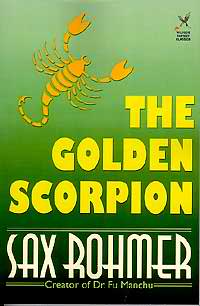
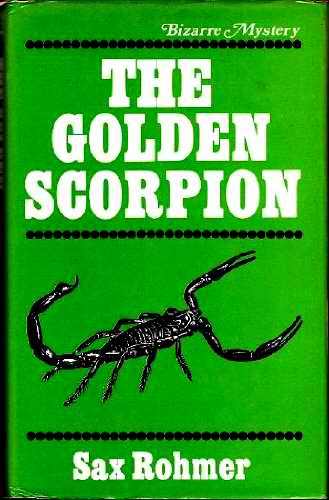 Sax Rohmer’s The Golden Scorpion was first printed in its entirety in The Illustrated London News Christmas Number in December 1918. It was published in book form in the UK the following year by Methuen and in the US in 1920 by McBride & Nast. Rohmer divided the novel into four sections. This week we shall examine the fourth part of the book, “The Lair of the Scorpion” which comprises the final seven chapters.
Sax Rohmer’s The Golden Scorpion was first printed in its entirety in The Illustrated London News Christmas Number in December 1918. It was published in book form in the UK the following year by Methuen and in the US in 1920 by McBride & Nast. Rohmer divided the novel into four sections. This week we shall examine the fourth part of the book, “The Lair of the Scorpion” which comprises the final seven chapters.
Rohmer gradually segued from following the model of his first Gaston Max mystery, The Yellow Claw (1915) in the first half of the book to more closely adhering to the blueprint provided by his Fu Manchu thrillers for the second half. Readers familiar with the Devil Doctor could not help to recognize this fact as the final part of the novel opens with Keppel Stuart recovering consciousness as a captive in Fo-Hi’s laboratory. Among the exotic Oriental furnishings are the familiar form of caged lizards and insects. Behind the advanced scientific apparatus stands the figure of the Scorpion himself. Fo-Hi at last takes center stage in the novel and there is no mistaking when he says he has tried to follow in the footsteps of the great scientist who preceded him in serving their organization’s mission in England. His speech and bearing instantly recall Dr. Fu Manchu.
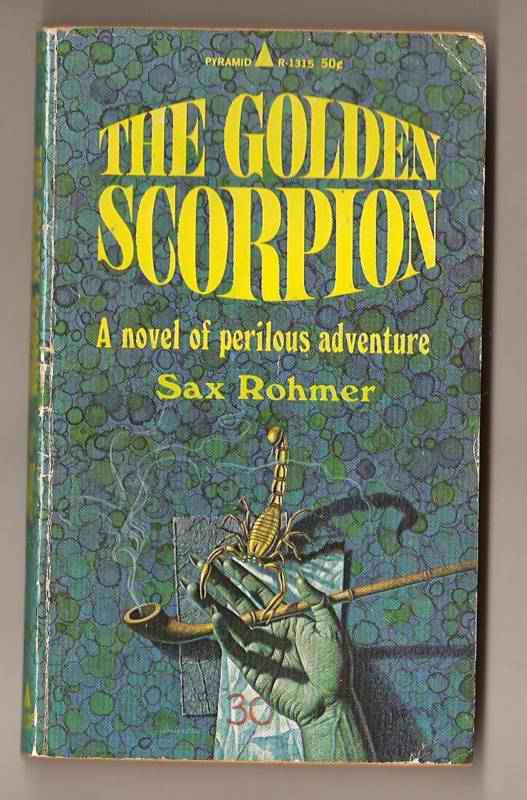
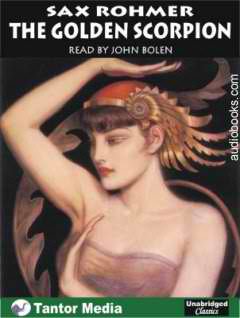 Fo-Hi reveals that Van Rembold, Sir Frank Narcombe, Henrik Ericksen, and Grand Duke Ivan only appeared to have been assassinated. These great men were victims of the cataleptic drug familiar from the Fu Manchu books and have been revived to serve the secret society whose ambitions Fo-Hi now leads in the West. The Scorpion has also reserved a place of honor for Dr. Stuart, if he desires, or else he can submit to persuasion from the Six Gates of Wisdom (another direct reference to the Fu Manchu series) or the Feast of a Thousand Ants. Fo-Hi reveals that the Ericksen Ray is the prize of the inventions he has brought to the Sublime Order with Keppel realizing that this was the disintegration ray that nearly ended his own life. Fo-Hi prepares for their imminent departure for China, believing that Scotland Yard will not hinder their passage.
Fo-Hi reveals that Van Rembold, Sir Frank Narcombe, Henrik Ericksen, and Grand Duke Ivan only appeared to have been assassinated. These great men were victims of the cataleptic drug familiar from the Fu Manchu books and have been revived to serve the secret society whose ambitions Fo-Hi now leads in the West. The Scorpion has also reserved a place of honor for Dr. Stuart, if he desires, or else he can submit to persuasion from the Six Gates of Wisdom (another direct reference to the Fu Manchu series) or the Feast of a Thousand Ants. Fo-Hi reveals that the Ericksen Ray is the prize of the inventions he has brought to the Sublime Order with Keppel realizing that this was the disintegration ray that nearly ended his own life. Fo-Hi prepares for their imminent departure for China, believing that Scotland Yard will not hinder their passage.
Following the Fu Manchu formula closely, as soon as Fo-Hi leaves his captive alone, Miska steals into the room and releases him from his bonds. She shows Keppel the passageway to escape and gives him an amulet for which Chunda Lal has sworn to obey the bearer. Keppel pleads with her to accompany him, but she explains that Fo-Hi has the power of life and death over her as she requires regular injections to prevent her from slipping into a cataleptic coma. No sooner does Keppel declare his love for her and make good his escape than Miska discovers Fo-Hi in the doorway having observed her treachery.
Fo-Hi reveals that he has given Chunda Lal orders to kill Dr. Stuart if he attempts to escape. He prepares to beat Miska for her betrayal, but casts the whip aside and, in sharp contrast to his celebrated predecessor, breaks down and declares his love for the slave girl. While Dr. Fu Manchu successfully sublimated all sexual impulses in order to channel his energies into his work, Fo-Hi fails in the disciplines of Rache Churan and is shown as vulnerable to the sting of unrequited love. Rohmer shows unexpected humanity from a villain whose face is always hidden behind a veil. This development of the Scorpion’s character proves both effective and surprisingly moving.
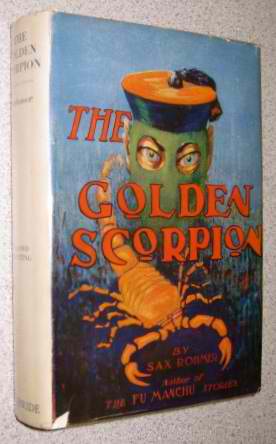
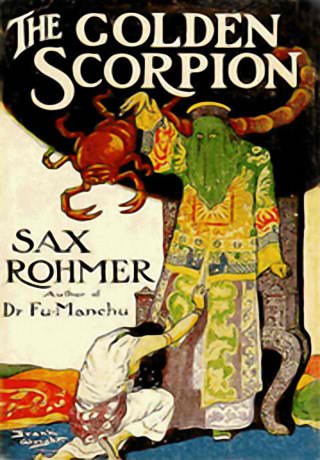 Chunda Lal enters the laboratory and tells his master he has done his bidding. Fo-Hi instructs him to beat the soles of Dr. Stuart’s bare feet with a split rod until he sounds a gong to end the torture. Chunda Lal bows and goes off to fulfil his master’s commands. Miska weeps at the sound of Keppel’s suffering. Fo-Hi gives her the power to end the torture by consenting to become his bride. Miska agrees and Fo-Hi sounds the gong. Chunda Lal returns and Fo-Hi departs, telling Miska to compose herself. Alone together, Chunda Lal shows Miska the amulet she had given Dr. Stuart and explains that he deceived Fo-Hi and set the Englishman free because of his love for Miska. He then tells her that Fo-Hi holds no power over her and that her injections are harmless, merely a way of Fo-Hi to control her out of fear. Pleading with her to escape and join Dr. Stuart, Chunda Lal shows her the blade with which he intends to murder their master. Rohmer outdoes himself here with three different characters madly in love with poor tragic Miska.
Chunda Lal enters the laboratory and tells his master he has done his bidding. Fo-Hi instructs him to beat the soles of Dr. Stuart’s bare feet with a split rod until he sounds a gong to end the torture. Chunda Lal bows and goes off to fulfil his master’s commands. Miska weeps at the sound of Keppel’s suffering. Fo-Hi gives her the power to end the torture by consenting to become his bride. Miska agrees and Fo-Hi sounds the gong. Chunda Lal returns and Fo-Hi departs, telling Miska to compose herself. Alone together, Chunda Lal shows Miska the amulet she had given Dr. Stuart and explains that he deceived Fo-Hi and set the Englishman free because of his love for Miska. He then tells her that Fo-Hi holds no power over her and that her injections are harmless, merely a way of Fo-Hi to control her out of fear. Pleading with her to escape and join Dr. Stuart, Chunda Lal shows her the blade with which he intends to murder their master. Rohmer outdoes himself here with three different characters madly in love with poor tragic Miska.
Keppel makes his way to freedom and soon encounters Sergeant Sowerby and Gaston Max. The Frenchman was only grazed by the bullet and Dr. Stuart laughingly tells him he has a skull “like a negro” in an unforgivable racist slur that cannot help but make modern readers wince in discomfort. Admittedly, such remarks are likewise found in the works of many writers of the era (Robert E. Howard, Edgar Rice Burroughs, and worst of all, H. C. McNeile, among others). One understands why publishers made minor alterations to texts despite promoting them as “complete and unabridged” in the paperback reprint series of the 1960s and 1970s. While I have never been a proponent of political correctness, casual racist slurs serving no purpose but to hurt others would be better deleted or at least softened. Not all of our past errors need be preserved in the name of textual integrity.
Meantime, our heroes meet up with Inspector Dunbar and coordinate a second raid with Dr. Stuart leading the way in an effort to take the Scorpion alive. The book reaches its climax not with a successful second police raid but in resolving the triangle between Miska, Fo-Hi, and Chunda Lal. The Scorpion begins to mesmerize Miska into becoming his willing lover. Chunda Lal attempts to stab his master to death and save Miska for himself. Fo-Hi exerts his hypnotic control over Chunda Lal and forces him to plunge the knife into his own heart and commit suicide. Miska makes good her escape and an enraged Fo-Hi sets fire to his laboratory to insure that none can learn his secrets. Miska is reunited with Keppel and, in turn, leads the detectives back to her master’s lair. They burst through the door just in time to see Fo-Hi turn the Ericksen Ray on himself and commit suicide. Gaston Max declares that it is “the way of the scorpion” in the abrupt, but breathtaking finale to this curious sidestep in the Fu Manchu series.
William Patrick Maynard was authorized to continue Sax Rohmer’s Fu Manchu thrillers beginning with The Terror of Fu Manchu (2009; Black Coat Press). A sequel, The Destiny of Fu Manchu was published earlier this year by Black Coat Press. Next up is a collection of short stories featuring an Edwardian detective, The Occult Case Book of Shankar Hardwicke and a hardboiled detective novel, Lawhead. To see additional articles by William, visit his blog at SetiSays.blogspot.com